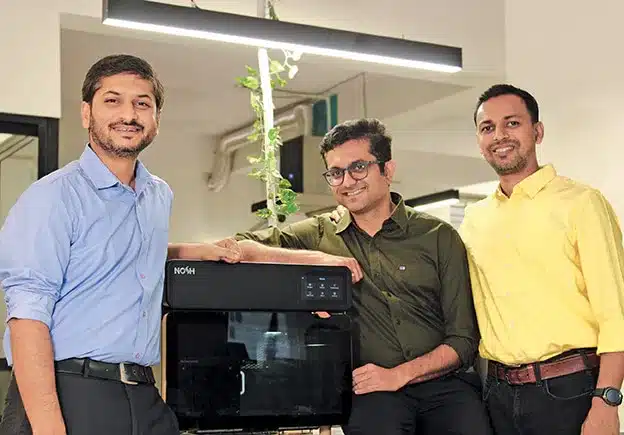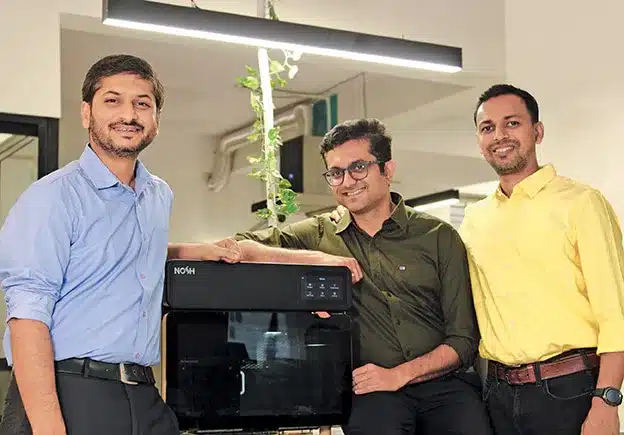
What if one got tired of cooking or bland takeout? A cooking robot came to the rescue, which even had to pass the ‘Mom’ test. Yatin Varachhia from NOSH tells EFY’s Nidhi Agarwal how this Bengaluru startup is redefining home-style meals with smart automation.

Q. What does your company do?
A. The company focused on building robots that make healthy, personalised meals. We began with the assumption that many in the younger generation, including millennials and Gen Z, do not enjoy cooking and often rely on quick or take-out food, which is not always healthy. The idea came from our own challenge as a working couple in Bengaluru, struggling to find a cook who could match our taste. After speaking with many others in cities and abroad, we realised this is a common problem—people often compromise on their food. We aim to solve this by automating kitchen tasks, allowing anyone to enjoy fresh, home-style food anytime, anywhere.
Q. How did the name NOSH come up?
A. We first named the company Euphotic Labs because we wanted to create happiness through automation. But many people found the name hard to remember. Later, a friend suggested the name NOSH, which means ‘no one sleeps hungry’. We liked it right away because it matched our goal.
Q: What kind of food can your product cook, and how fast is it compared to traditional cooking?
A: It can cook anything usually made in a pan, pot, or cooker—like sabji, curry, rice, biryani, halwa, soups, and more. As long as it is a one-pot dish, the robot can handle it. It follows the same cooking process you would use at home, so the cooking time is similar. We did not speed it up artificially because we wanted to maintain the taste and authenticity. The robot just automates the steps for you.
Q. What were the main design challenges in automating such a multi-step process?
A. Our first big challenge was getting the taste right. That was our main focus in the first year. We had to design and build spice and ingredient dispensers that could handle a wide range of food items, including spices, herbs, vegetables, meat, sauces, and more. Then we had to solve the problem of cooking itself. Human hands can move in many ways, but robots cannot, so making a robot that can stir and cook properly with just one or two motors was difficult. After that, we had to make the whole system small enough to fit into a regular kitchen, like the size of a microwave. We also had to make it reliable for daily use and easy to clean, using food-safe materials and a design that prevents food from getting stuck in hard-to-clean places.
We decided to keep the process exactly like how a human would cook. The goal was that people should not be able to tell if the food was made by a machine or by hand. We were so serious about this that we said if the food does not taste good, we will not launch the product at all.
Apart from the tech side, building a hardware company came with its own set of problems. It is harder to raise money for hardware than for software. Good hardware engineers are also hard to find. On top of that, getting parts made in India was not easy. Vendors and suppliers often do not follow timelines or maintain consistent quality. So we have had to solve both engineering and business challenges along the way.
Q. Do you have an in-house design team, or do you source everything externally?
A. Our challenge is different from what others face because we had to build a system from scratch. Most of our parts are custom-made. Even though we are solving a new problem, we have always had one key idea: do not reinvent what already works. For example, we did not try to make our own power supply; we bought a proven one. The idea is to use ready-made, tested parts wherever possible, and only create custom solutions where it adds value for the customer.
Q. How do you solve problems and improve your design?
A. We improve our design step by step, starting from scratch with many ideas. Having a clear plan helps us make decisions. Brainstorming gives us good solutions, but the key is building and testing prototypes quickly. Instead of endless discussions, we focus on building. If it works, great; if not, we try again. That is our approach—just keep building.
Q. Building hardware can be costly. How did you manage the cost for your prototype?
A. Prototyping is costly, but we were lucky to get government grants of ₹12.5 million in total that covered it. We had limits on hiring, not on building. So we focused on testing small parts instead of full products. For example, to test a new dispensing method, we would build a simple setup, not the whole product. We used 3D printing and DIY tools to test quickly and cheaply. Our approach was simple: define the problem clearly, test only what matters, and keep improving step by step.
Q. What challenges did you face when transitioning from prototyping to mass production?
A. The team has grown to 40 people, including manufacturing, quality, customer support, service, software, machine learning, artificial intelligence (AI), mechanical, electronics, and design verification teams, along with a business team for sales, marketing, operations, and human resources (HR). Moving from prototyping to mass production was a big challenge. We initially thought that creating a great design would make production fast, but that was not the case. We faced many challenges because we underestimated production and did not put in enough effort to prepare for it.
Q. How does electronics play a role in it?
A. Electronics are the core of our robot—they control all the motors and sensors. A camera watches the pan, and edge AI checks if the onions are caramelised, the curry has released oil, or the rice is cooked right. The mechanical parts move through motors, which are controlled by the electronics. We use around eight different printed circuit boards (PCBs) for sensors, motor control, and the AI unit. Everything works together through electronics to make the cooking happen.
Q. How do AI and sensors work together in your cooking robot?
A. The robot uses several smart sensors and AI to ensure perfect cooking. A camera watches the pan, a thermal sensor checks heat, and a torque sensor gauges the thickness of gravies. AI uses this input to determine when onions are golden brown, oil has separated from the curry, or rice is cooked properly. It also adjusts based on ingredient variation, like size or ripeness of tomatoes. All of this runs locally, so cooking continues even if Wi-Fi goes out.
Q. How would you copy the way a human hand steers?
A. We use a simple rotating motion because motors are best at that. The challenge was to design a spatula that could mimic human stirring, bringing food from the bottom to the top and mixing everything evenly. Since ingredients vary in size, from big pieces like chicken to fine ones like rawa, we had to make sure the same motion works for all. After many design iterations, we created a solution that handles all types of mixing using just one smart rotary motion.
Q. What are the biggest integration challenges?
A. When different teams or systems work together, the main challenge is often the unclear interface between them, leading to confusion and blame. The issue is usually not with a team, but with the interface not covering all scenarios. Connecting cloud to mobile or cloud to device is straightforward, but problems arise between the device and motor controller, where syncing and a custom protocol create more complexity.
Q. How do you handle manufacturing and IP protection, and are you planning to build your own factory?
A. We are currently relying on contract manufacturing, which works well because experts handle production and labour, which are tough areas for a tech company. A good contract manufacturer has strong intellectual property (IP) protection and clear agreements. We also split responsibilities—some parts we control, others they handle. For now, we are not planning our own factory, but if volume grows beyond what contract manufacturers can handle, we will reconsider.
Q. Who handles sourcing the components, you or the manufacturer?
A. We have a supply chain team that provides trusted suppliers to the contract manufacturer. The contract manufacturer must get parts from these suppliers, though they have some freedom to choose partners. However, for most parts, they must use the suppliers we provide.
Q. How does your internal team handle product testing?
A. We have many tests for each part of the design to make sure it works. For example, we do 5000 cycles of testing, which is a basic requirement. Any design changes must go through these 5000 cycles to build trust. We also test for vibration by following road and ship shipment standards. We do drop tests and environmental tests to check the product’s durability over time, testing everything to make sure it is right.
Q. How many units have you sold, and can you share the revenue?
A. We have sold 600 units so far, and have delivered 130 of them. The remaining 500 units are still in process, some are with logistics, and some are on the production line. We started in Bengaluru in August 2023 and waited for early feedback, which took about 6 months. So far, we have received around ₹30 million from customers, though we have not booked the revenue yet.
Q. Do you have competitors, and how do you stand out from them?
A. Nimbal Lab is one of our competitors. Many are working on this, but only us and Nimbal Lab have reached the production stage. Our design stands out with front access and a closed chamber, allowing you to command it to cook and walk away confidently. It can easily fit in a cabinet, making placement simple with your interior designer. We also designed it so even a 6-year-old can cook, with hidden gears and mechanisms for safety and ease. These design features set us apart.
Q. What are your biggest challenges as a startup and your focus going forward?
A. Our biggest challenge now is creating the market. Since it is a new product in a new category, adoption is slow, and we are focused on building that. We are also investing in marketing, sales, improving future products, and optimising the supply chain. The real question is not just whether we have built a great product—but whether we can build a great market for it. That is our key focus.
Q. Are you looking to add new partners or distributors?
A. We will build it up slowly. Right now, we are focused on end-to-consumer (E2C) because we first need to learn how to sell it. Once we figure that out, we can let others help. Our plan is to start with Amazon and then move to retail partners or distributors. For now, the product is only available online, on our website and Amazon.
Q. Are you looking to partner with academia to boost innovation?
A. I am from Indian Institute of Science (IISc), where we have a strong connection and work well together. We are also building a relationship with the Indian Institute of Technology (IIT) Madras and have a good partnership with the Sardar Patel Institute of Technology (SP and IT) in Surat. Collaborating with institutions really helps, especially for a deep-tech company like ours.










